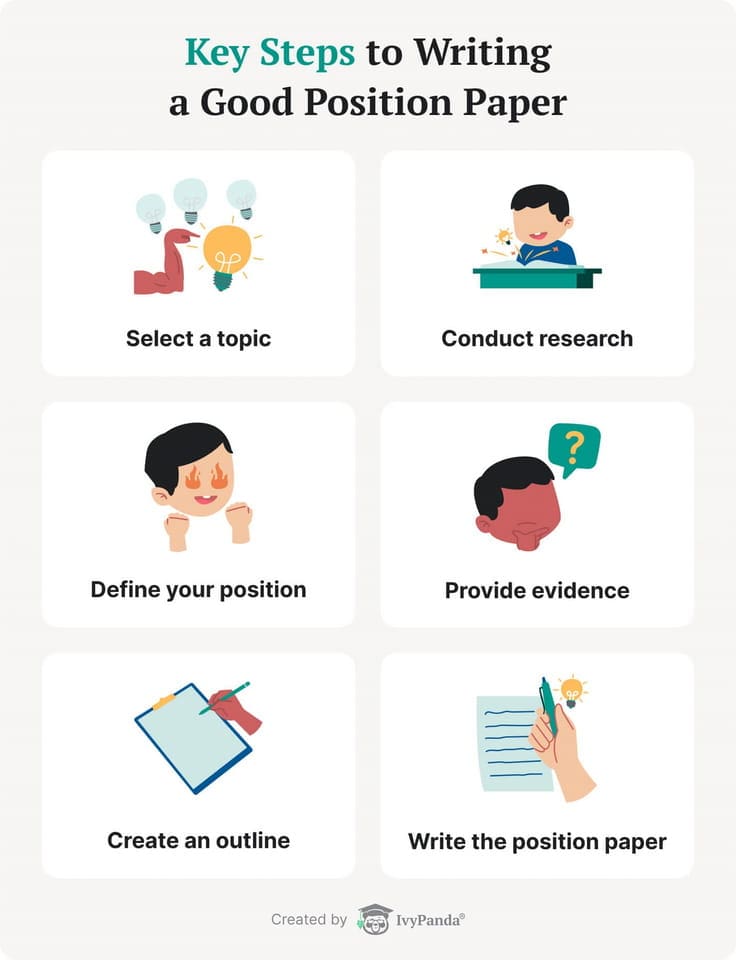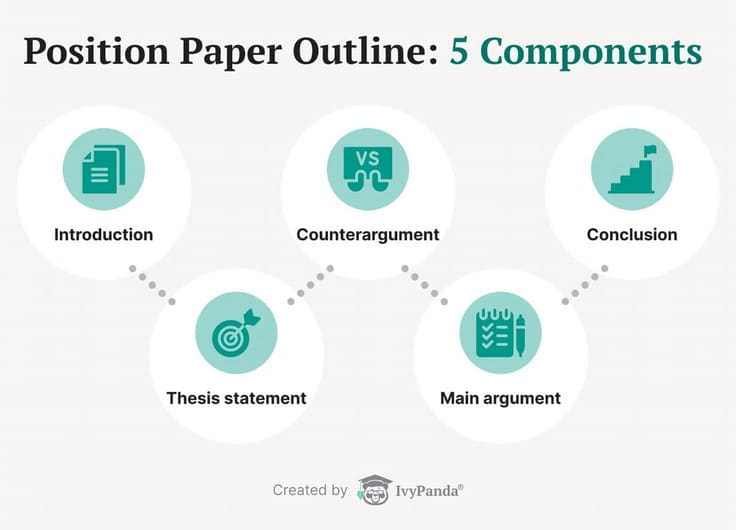Position Paper Maker for Students
The Position Paper Maker is here to help you create a clear and well-supported stance on any topic. This tool guides you through organizing your main argument, supporting points, and counterarguments, making it easy to develop a convincing position paper with confidence.
🤖 Intro to Our Free Position Paper Maker
Students in all academic fields, including medicine, economics, and business, often come across the need to write a position paper. This assignment serves as a tool for persuading others of your ideas, beliefs, and values. That’s why writing a good position paper will demand solid persuasive skills and multi-faceted research efforts on your part.
Our position paper maker can significantly simplify the process. To help you even further, we’ve included a detailed guide on writing a position paper with valuable tips and recommendations. Let’s get started!
🪄 Pros of Our Position Paper Maker: Free Use & More
Our free, AI-powered tool was made to simplify the process of position paper writing. Here are the benefits you’re guaranteed when using this smart assistant:
Position Paper Maker Online: How It Works
Using our free position generator is very easy, even for newbies. Here are the steps you should take to get the sample:
- Indicate your paper topic.
- Specify the number of paragraphs.
- Click the “Make Position Paper” button.
- Get a great position paper example!
🧐 What Is a Position Paper?
In simple terms, a position paper is an academic assignment that voices the author’s position on a specific topic. It is a structured text that explains a particular stance on an issue and evaluates it. If the topic is assessed negatively, the author should also recommend ways to fix the situation.
Position papers are not given exclusively in schools. For example, opinion pieces published in journals also belong to this genre.

You can typically find position papers in such academic areas as:
- Governance
- Political science and practice
- Business
- Economics
- Medicine and health
- Education
- Social issues, and many more.
5 Popular Types of Position Paper
A position paper is a multi-functional assignment that fits many academic disciplines. There are several types of position papers, each with its specific characteristics and goals.
Here are the most popular types you should know about:
- Problem-solution position paper. This is a classic form of a position paper that identifies a problem and proves that it can be solved with the help of some action. After that, the author offers an evidence-based solution to address the concern effectively.
- Predictive position paper. In this assignment type, you should make a prediction about a certain topic and evaluate potential trends. You may also suggest possible response ideas or preparatory tactics.
- Counterargument position paper. This type of writing addresses some argument and provides convincing evidence against it. This way, you may overturn the proposed plan in favor of a more successful option.
- Advocacy position paper. In an essay of this type, you advocate for a particular cause and provide arguments in favor of the proposed action or policy.
- Personal position paper. As the name suggests, this paper voices the author’s position and arguments for or against the chosen issue. It relies more loosely on external evidence and may be solely based on the person’s subjective reasoning.
🖊️ How to Write a Good Position Paper
Below, we will cover the main stages of writing a position paper. You can also use this guide to enhance your generated sample if it has missing elements.

-
Select your topic.
Deciding an appropriate topic is at the heart of any successful position paper project. Make sure your topic is relevant and debatable. It’s also vital to understand whether the issue's scope is manageable. -
Conduct research.
Next, you need to scan the Web or your college library for credible sources. Read various sources to see what experts say on the subject. You should also review several academic databases to see whether there’s enough reliable scholarly evidence to back up your points. -
Define your position.
Now that you’re well-informed on the topic, you can take a stand and use reliable facts to prove it. Choose whether you’re for or against some claim or policy, then move on to substantiation. -
Find supporting evidence.
Collect information from sources that will back up your claims and help you sound convincing. -
Create an outline.
Write a brief plan of the paper’s structure. This will help you ensure you have all vital elements in place following the predetermined line of reasoning. -
Write the paper.
Now, it’s time to compose the full text of your position paper and lay out all of your arguments. Once you’re done writing, don’t hurry to submit it to the professor. First, you’ll need to re-read the text and correct all typos and inconsistencies.
What Are the 5 Parts of a Position Paper?
A position paper should have the following five parts in its model structure:
- Issue: formulate the topic you’re going to discuss.
- Thesis statement: indicate your stance on the identified issue.
- Reasons: give a rationale for your position.
- Evidence: state the facts and provide evidence that argues in favor of your position.
- Counterarguments: anticipate and refute opposing arguments to make your position more convincing.
📝 Position Paper Outline
Below, you will find information about all elements of a position paper. You can use it to write a detailed outline and ensure your position paper is well-organized.

- Introduction. The opening section should lay out your subject and grab the readers’ attention. Start the paper with a catchy hook to keep the audience glued to your essay. Lastly, provide background information and state your thesis.
- Counterargument. By giving the readers a counterargument first, you reserve the rest of your paper's body for refuting this position and proving why it is wrong. That’s why it makes sense to start with an opposing view as a backdrop for further reasoning.
- Main argument. Now that you’ve briefly covered a counterargument, it’s time to give solid evidence that proves your point and solidifies your position. In this part, you should voice your opinion, show why it is more credible, and deliver supporting data and facts.
- Conclusion. The concluding section is a recap of all significant arguments and key takeaways that will leave your audience with a lasting impression. Make sure you stress only the most critical points to close the paper on a persuasive note.
🎁 9 Helpful Tips for Writing Position Paper
Our practical tips will help you improve your position paper and make it sound much more convincing. Check them out:
-
Identify your audience.
Writing for specific audiences is always more successful and impactful than producing generic texts. Take your readers’ characteristics into account when choosing arguments and even vocabulary. -
Create a strong thesis statement.
Your central claim is the essential part of your position paper. Make sure it sounds straightforward, accurate, and convincing. -
Include background.
Giving background facts on the subject shows that you have researched the topic profoundly. It also ensures your readers understand the issue much better. -
Provide both opinions.
You should always give credit to counterarguments since failing to address them makes your writing biased. -
State your position.
Recognizing the presence of debate and controversy on the chosen topic is not enough. It’s important to be clear about your stand on the issue. -
Practice persuasion.
Study various persuasive techniques in writing. Try to use each to see which matches your context and writing style. -
Use concise language.
Position papers can’t be ambiguous and uncertain. That’s why you should voice your position explicitly. -
Stay objective.
Denying objective facts because they fall under your counterarguments is unprofessional. You should competently address all facts to be ethical in your reasoning. -
Cite sources properly.
The intellectual labor of other scholars should be appreciated, which is why it's vital to give credit to your sources. It’s part and parcel of the academic code of ethics. We recommend using our citation generator to accelerate the process.
How Can I Make My Position Paper Better?
Think of your position paper as a debate and argue with imaginary opponents to make your ideas more convincing. There’s no sense in repeating the self-obvious facts. Instead, you can offer a critical commentary addressing the problem's essence.
Check out the examples of effective and ineffective arguments below:
- Ineffective: There is still much debate around the practice of using uniforms in public schools.
- Effective: School uniforms are a viable tool in the administrators’ hands, as they help achieve student population consistency, prevent bullying, and create a shared sense of belonging.
As you can see, unlike the first example, the second one comprehensively shows the issue and what ignoring it leads to. Such an argument is well-rounded and thought-provoking.
What Is the Best Topic for Making a Position Paper?
The choice of topic matters a lot when it comes to creating a successful position paper. Here are several great topic examples to help you understand what is expected from you:
- Modern approaches to addressing a bioethical dilemma of animal research.
- United Nations and UNESCO have failed their missions.
- What are the implications of cultural appropriation in contemporary cinema?
- Advancements that artificial intelligence has brought to medical practice.
We hope our AI-based generator and guide helped you craft a perfect position paper. Feel free to share this article with friends! We also recommend trying our great article critique maker to streamline your academic work.
🔗 References
- How to Write a Winning Position Paper. – Toni Lawrence, Anish Vedantham, Best Delegate
- Writing a Position Paper. – Courtesy of University of Hawaii
- How to Write a Position Paper. – Johnson County Community College
- How to Write a Position Paper | Everything About It. – David Lucas, Medium
- Position Papers – Metropolitan Community College
- Guide to Writing Position Papers. – The Ivy League Model United Nations Conference
- Researching Your Assignment and Writing Your Position Paper. – Dr. Matthew Bolton, Pace University